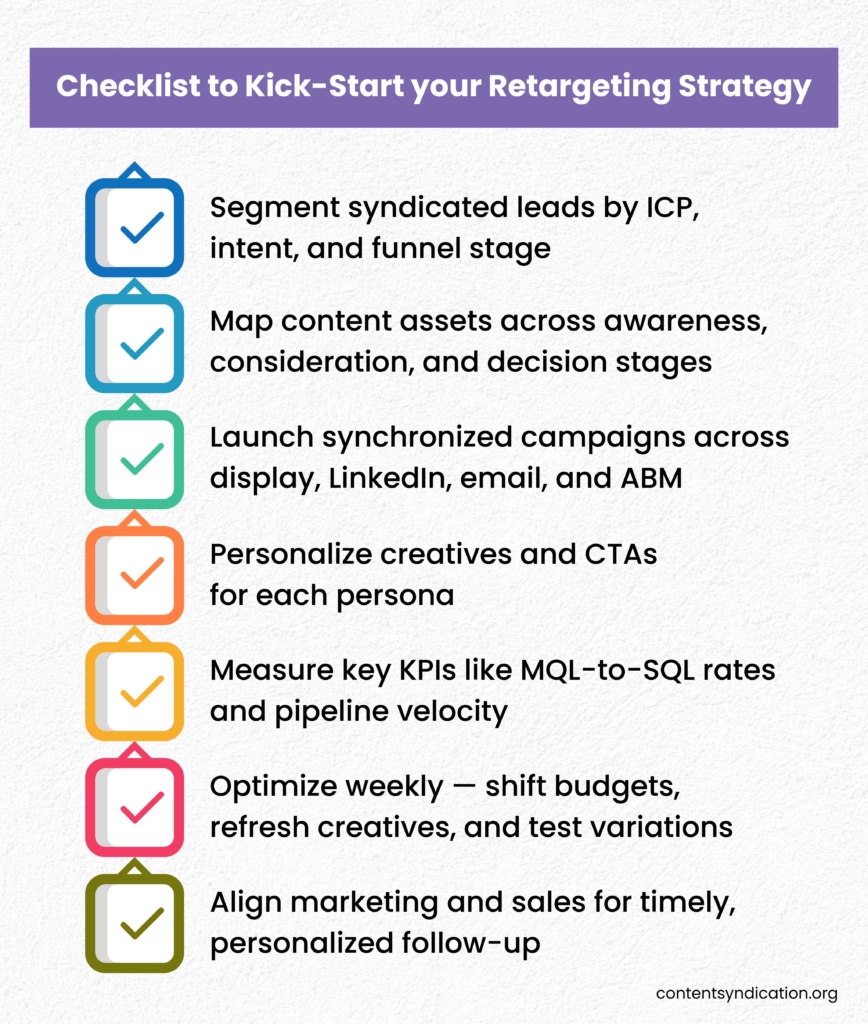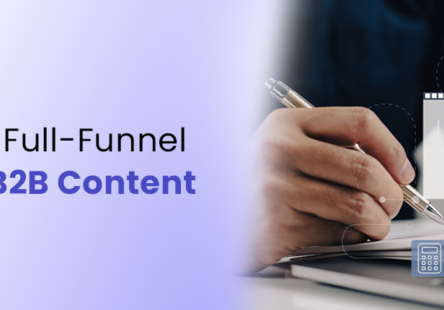You spend substantial time and budget on content syndication, yet your pipeline isn’t growing.
Is it because your leads are not of good quality? Maybe. But the truth is, you are losing many high-quality leads because you’re overlooking retargeting.
Retargeting helps warm up your leads and prevents them from fading into cold storage. In fact, without an integrated retargeting plan, your pipeline can lose up to 80% of potential opportunities from syndicated leads.
Saving 80% isn’t going to be a walk in the park. It takes a strategic, step-by-step process through multi-channel retargeting.
Step-by-Step Guide to Retargeting Syndicated Content for B2B Leads
Step 1: Capture Syndicated Leads (and Segment Smarter)
The foundation of effective retargeting is data. It must be clean, structured, and actionable. It starts with how you capture and categorize syndicated leads.
1. Start with ICP Alignment
Define your Ideal Customer Profile (ICP) before launching syndication campaigns. Include parameters such as:
- Industry: B2B tech, SaaS, or IT services
- Company size: Align with your product’s target segment
- Geography: Prioritize relevant regions (e.g., North America, EMEA)
- Decision-makers: Titles like CMO, Demand Gen Head, or Sales VP
So choosing syndication partners that specialize in reaching your ICP ensures that every downloaded lead already fits your target mold.
2. Capture Smarter Data
Don’t limit forms to name and email fields. Focus on collecting contextual information that aids retargeting:
- Company name and job title
- Pain points or buying challenges
- Technology stack or area of interest
- Budget authority or decision-making role
Progressive forms and pre-qualification questions help gather richer insights without overwhelming the user.
3. Integrate Intent Data
Overlay third-party intent data from platforms like Bombora or G2 to identify accounts already showing purchase intent. Use it to:
- Prioritize high-fit, high-interest accounts
- Understand what topics or keywords they’re researching
- Segment leads based on intent intensity and engagement level
Outcome
By the end of this stage, you should have segmented lead lists based on:
- Buyer stage (Awareness, Consideration, Decision)
- Intent level (Low, Medium, High)
- Account fit (Ideal, Mid-fit, Low-fit)
These segments form the blueprint for precise, multi-channel retargeting.
Step 2: Prepare Multi-Channel Retargeting Assets
Once you’ve captured leads, the next step is content mapping. Make sure you align the right message with each stage of the buyer journey.
Map Content to Every Funnel Stage
- Top-of-funnel (Awareness): eBooks, research reports, checklists, and industry insights.
- Middle-of-funnel (Consideration): Webinars, case studies, solution comparisons, and guides.
- Bottom-of-funnel (Decision): Demos, ROI calculators, customer testimonials, or executive briefings.
Create a Content Journey Example
A typical journey could look like this:
- Syndicated Download: eBook on “2025 B2B Lead Generation Trends”
- Retargeting Ad: Case study on “How XYZ Tech Achieved 3x Conversions”
- Email Follow-up: Invitation to webinar or personalized demo
This sequence gently moves leads from initial awareness to consideration and ultimately conversion without feeling forced or repetitive.
Pro Tip
Repurpose top-performing assets.
Turn webinars into blog snippets, break whitepapers into carousel ads, or extract stats for infographics. The more you diversify formats, the greater your cross-channel consistency.
Step 3: Launch Retargeting Campaigns Across Channels
Now it’s time to put your multi-channel engine in motion. Each platform serves a unique purpose in keeping your leads engaged.
1. Display Retargeting
Use the Google Display Network or programmatic DSPs to reach leads as they browse across the web.
- Ideal for broad reach and brand recall
- Display banners can feature case studies, upcoming events, or success metrics
- Ensure clear CTAs like “Watch Now,” “Learn More,” or “See How It Works”
Best for: Awareness and repeated exposure
2. LinkedIn Retargeting
Upload your lead lists to LinkedIn Matched Audiences and run targeted campaigns by company, title, or industry.
- Sponsored Content for thought-leadership assets
- Message Ads for personalized invitations
- Dynamic Ads for event or webinar promotions
Best for: Precision targeting and brand reinforcement among decision-makers
3. Email Remarketing
Email is your direct line to personalized engagement. Set up nurture sequences triggered by lead activity:
- For awareness-stage leads: send educational blogs or short guides
- For consideration-stage leads: share case studies or webinar replays
- For decision-stage leads: deliver demos, pricing info, or ROI calculators
Best for: Building trust through tailored, timely communication
4. Account-Based Retargeting (ABM)
When targeting high-value accounts, go beyond individuals and reach entire buying committees.
Use coordinated ads across display, LinkedIn, and even IP-based targeting to engage multiple stakeholders simultaneously.
Best for: Complex buying cycles and enterprise accounts
Sample Campaign Flow
- Day 0–2: Launch LinkedIn Sponsored Ads
- Day 3–5: Serve programmatic or display ads
- Day 6–10: Trigger nurture emails
- Day 10+: Launch ABM retargeting for high-fit accounts
Pro Tip: Begin retargeting within 24–48 hours of the initial syndication download — when brand recall is strongest.
Step 4: Personalize and Optimize Messaging
Personalization separates effective retargeting from generic campaigns. Every channel, message, and visual should align with the lead’s persona and funnel stage.
1. Segment and Personalize
Create variations in tone, message, and visuals for different personas:
- CMO: Focus on strategic ROI and growth outcomes.
- Marketing Manager: Emphasize efficiency and lead quality.
- SDR Manager: Highlight productivity and conversion metrics.
2. Tailor Messaging by Funnel Stage
- Awareness: “Thanks for downloading! See how industry leaders are transforming lead gen.”
- Consideration: “Discover how [Peer Company] cut CPL by 35% — get the case study.”
- Decision: “Ready for real results? Book a custom demo today.”
3. Maintain Brand Consistency
Keep visuals, tone, and colors consistent across every ad, email, or landing page. This ensures your brand feels familiar and cohesive no matter where prospects engage.
4. Test and Optimize
A/B test your creatives and CTAs regularly:
- Test variations of headlines, imagery, and offer language.
- Monitor click-through and conversion rates per channel.
- Refresh creatives every 2–4 weeks to prevent ad fatigue.
5. Use Intent-Based Triggers
Behavior-based automation enhances personalization. For instance:
- If a lead visits your pricing page, trigger decision-stage ads.
- If they engage with awareness content, promote next-level resources.
Pro Tip: Mirror messaging across channels to create a “surround sound” effect — where your message feels unified, consistent, and omnipresent.
Step 5: Measure, Refine, and Accelerate Pipeline
Your retargeting success hinges on how well you measure and optimize campaign performance. Go beyond clicks and impressions. Focus on metrics that indicate pipeline acceleration.
1. Track Core KPIs
Monitor both engagement and conversion metrics:
- Lead-to-MQL conversion rate
- MQL-to-SQL progression rate
- Cost per opportunity and cost per meeting booked
- Channel-specific performance: impressions, CTR, form fills, downloads
- Pipeline velocity: average days from syndication to sales interaction
2. Build Insightful Dashboards
Create a marketing dashboard that visualizes your funnel:
Download → Retargeting Engagement → Email Nurture → SQL → Opportunity.
Use this to attribute conversions across touchpoints and understand which channels drive the highest ROI.
3. Optimize Weekly
- Reallocate budgets to high-performing campaigns
- Pause or tweak underperforming creatives
- Update segments based on latest engagement or intent data
4. Align With Sales
Marketing and sales alignment is non-negotiable. Share insights such as:
- Which leads engaged most recently
- What topics or assets they interacted with
- Which accounts are showing repeat engagement
This enables your sales team to follow up quickly and contextually, turning warmed-up leads into meetings.
5. Track Attribution
Use UTM parameters and marketing automation to track every interaction, from ad impressions to final deal closure. This helps prove the direct revenue impact of your retargeting strategy.
Pro Tip: Combine multi-touch attribution with CRM insights to show how retargeted leads convert faster and at higher deal values.

Conclusion:
Content syndication fills the top of your funnel. However, without retargeting, most of those leads never move forward.
Retargeting acts as the connective tissue between awareness and action. This way, your brand remains visible, relevant, and persuasive throughout the buyer’s journey.
By implementing this step-by-step framework, you can:
- Segment smarter using ICP and intent data
- Retarget across multiple channels for maximum visibility
- Personalize messaging for each persona and funnel stage
- Measure and optimize continuously for better ROI
When done right, multi-channel retargeting doesn’t just boost conversions. It transforms syndicated leads into predictable revenue.




